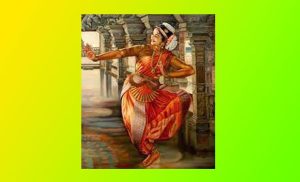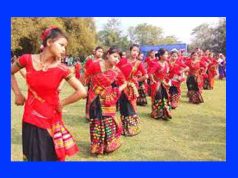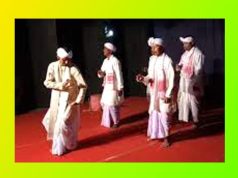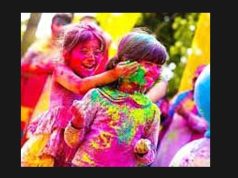প্ৰাচীন ভাৰতত চৌষষ্ঠি কলাই বিশেষ প্ৰসিদ্ধি লাভ কৰিছিল। এই কলাসমূহে মানুহৰ জীৱনক সমৃদ্ধ আৰু পূৰ্ণাঙ্গ কৰি তুলিছিল। বাৎসায়নে তেওঁৰ কামসূত্ৰত চৌষষ্ঠি কলাৰ উল্লেখ কৰিছে। এই কলাসমূহে মানুহৰ দৈনন্দিন জীৱন, সংস্কৃতি, আৰু কলাৰ ওপৰত গভীৰ প্ৰভাৱ পেলাইছিল।
চৌষষ্ঠি কলা। 64 Kola
প্ৰাচীন ভাৰতত চৌষষ্ঠি কলাই প্ৰসিদ্ধি লাভ কৰিছিল।বাৎসায়নে তেওঁৰ কামসূত্ৰত চৌষষ্ঠি কলাৰ উল্লেখ কৰিছে। সেই চৌষষ্ঠি কলাৰ কেইবিধমান হ’ল–গীত, বাদ্য, নৃত্য, আলেখ্য, বিশেষকেচ্ছদ্য, পুষ্পাস্তৰণ, দশনবসনাংগৰাগ, মণিভূমিকা কৰ্ম, শয়ন ৰচনা, উদকবাদ্য, উদকাঘাত, চিত্ৰযোগ, মাল্য গথনবিকল্প, নেপথ্য প্ৰয়োগ, কৰ্ণ পত্ৰভংগ, গন্ধযুক্তি, ভূষণ যোজন, ঐন্দ্ৰজাল,সূত্ৰক্ৰীড়া, বীণাডমৰুক বাদ্য, প্ৰহেলিকা, তক্ষণ, বাস্তুবিদ্যা আদি। 0 0 0
চৌষষ্ঠি কলা: প্ৰাচীন ভাৰতৰ এক বিস্ময়
প্ৰাচীন ভাৰতত চৌষষ্ঠি কলাই বিশেষ প্ৰসিদ্ধি লাভ কৰিছিল। এই কলাসমূহে মানুহৰ জীৱনক সমৃদ্ধ আৰু পূৰ্ণাঙ্গ কৰি তুলিছিল। বাৎসায়নে তেওঁৰ কামসূত্ৰত চৌষষ্ঠি কলাৰ উল্লেখ কৰিছে। এই কলাসমূহে মানুহৰ দৈনন্দিন জীৱন, সংস্কৃতি, আৰু কলাৰ ওপৰত গভীৰ প্ৰভাৱ পেলাইছিল।
চৌষষ্ঠি কলাৰ তালিকা:
- গীত: সংগীতৰ জ্ঞান আৰু গীত গোৱাৰ কলা।
- বাদ্য: বাদ্যযন্ত্ৰ বজোৱাৰ কলা।
- নৃত্য: নৃত্য কলা আৰু নৃত্যৰ বিভিন্ন ভংগীমা।
- আলেখ্য: চিত্ৰাঙ্কনৰ কলা।
- বিশেষকেচ্ছদ্য: বিশেষ কাহিনী ৰচনা আৰু কাহিনী বৰ্ণনা।
- পুষ্পাস্তৰণ: ফুলৰ মালা গাঁথা আৰু ফুলৰ সজোৱা।
- দশনবসনাংগৰাগ: দাঁত, বস্ত্ৰ আৰু শৰীৰ সজোৱা।
- মণিভূমিকা কৰ্ম: মণি আৰু ৰত্নৰ ব্যৱহাৰ আৰু সজোৱা।
- শয়ন ৰচনা: শয়নৰ স্থান সজোৱা।
- উদকবাদ্য: পানীৰ সৈতে সংগীত সৃষ্টি।
- উদকাঘাত: পানীৰ সৈতে খেল।
- চিত্ৰযোগ: চিত্ৰ আঁকা আৰু চিত্ৰৰ সজোৱা।
- মাল্য গথনবিকল্প: মালা গাঁথা আৰু সজোৱা।
- নেপথ্য প্ৰয়োগ: নাটকৰ নেপথ্য সজোৱা।
- কৰ্ণ পত্ৰভংগ: কাণৰ অলংকাৰ সজোৱা।
- গন্ধযুক্তি: সুগন্ধি তৈয়াৰ আৰু ব্যৱহাৰ।
- ভূষণ যোজন: অলংকাৰ সজোৱা।
- ঐন্দ্ৰজাল: যাদু কলা।
- সূত্ৰক্ৰীড়া: সূত্ৰৰ সৈতে খেল।
- বীণাডমৰুক বাদ্য: বীণা আৰু ডমৰু বজোৱা।
- প্ৰহেলিকা: ধাঁহা আৰু ধাঁহাৰ সমাধান।
- তক্ষণ: কাঠৰ কাম।
- বাস্তুবিদ্যা: বাসগৃহৰ স্থাপত্য আৰু সজোৱা। ইত্যাদি
চৌষষ্ঠি কলাৰ গুৰুত্ব:
এই কলাসমূহে মানুহৰ দৈনন্দিন জীৱনক সমৃদ্ধ কৰি তুলিছিল। ইহঁতে মানুহৰ সৃষ্টিশীলতা আৰু কলাৰ প্ৰতি আগ্ৰহ বৃদ্ধি কৰিছিল। চৌষষ্ঠি কলাৰ জ্ঞানৰ দ্বাৰা মানুহে নিজৰ জীৱনক অধিক আনন্দময় আৰু সমৃদ্ধ কৰি তুলিব পাৰিছিল।
চৌষষ্ঠি কলা: প্রশ্নোত্তৰ
প্ৰশ্ন ১: চৌষষ্ঠি কলা কি?
উত্তৰ: চৌষষ্ঠি কলা হৈছে প্ৰাচীন ভাৰতত প্ৰচলিত ৬৪ বিধ কলা, যিয়ে মানুহৰ দৈনন্দিন জীৱন আৰু সংস্কৃতিৰ ওপৰত গভীৰ প্ৰভাৱ পেলাইছিল।
প্ৰশ্ন ২: চৌষষ্ঠি কলাৰ উল্লেখ ক’ত পোৱা যায়?
উত্তৰ: চৌষষ্ঠি কলাৰ উল্লেখ বাৎসায়নৰ কামসূত্ৰত পোৱা যায়।
প্ৰশ্ন ৩: চৌষষ্ঠি কলাৰ কেইবিধমান উদাহৰণ কি?
উত্তৰ: চৌষষ্ঠি কলাৰ কেইবিধমান উদাহৰণ হৈছে গীত, বাদ্য, নৃত্য, আলেখ্য, পুষ্পাস্তৰণ, মণিভূমিকা কৰ্ম, উদকবাদ্য, চিত্ৰযোগ, মাল্য গথনবিকল্প, গন্ধযুক্তি, ভূষণ যোজন, ঐন্দ্ৰজাল, সূত্ৰক্ৰীড়া, বীণাডমৰুক বাদ্য, প্ৰহেলিকা, তক্ষণ, বাস্তুবিদ্যা আদি।
প্ৰশ্ন ৪: চৌষষ্ঠি কলাৰ গুৰুত্ব কি?
উত্তৰ: চৌষষ্ঠি কলাৰ গুৰুত্ব হৈছে যে এই কলাসমূহে মানুহৰ দৈনন্দিন জীৱনক সমৃদ্ধ আৰু পূৰ্ণাঙ্গ কৰি তুলিছিল। ইহঁতে মানুহৰ সৃষ্টিশীলতা আৰু কলাৰ প্ৰতি আগ্ৰহ বৃদ্ধি কৰিছিল।
প্ৰশ্ন ৫: চৌষষ্ঠি কলাৰ জ্ঞানৰ দ্বাৰা কি লাভ হৈছিল?
উত্তৰ: চৌষষ্ঠি কলাৰ জ্ঞানৰ দ্বাৰা মানুহে নিজৰ জীৱনক অধিক আনন্দময় আৰু সমৃদ্ধ কৰি তুলিব পাৰিছিল। 0 0 0
.
64 Arts (Chausath Kala)
The concept of the 64 Arts (Chausath Kala) holds a significant place in Indian culture, particularly as referenced in Vātsyāyana’s ‘Kāmasūtra’. These arts encompass a wide range of skills and disciplines, meant to enhance personal refinement, social grace, and intellectual development. While the ‘Kāmasūtra’ is often associated with topics of love and relationships, it also advocates for holistic cultivation of one’s abilities in both intellectual and practical spheres.
The Concept of 64 Arts
In ancient Indian culture, the mastery of these arts was considered essential for an individual’s personal growth, especially for those in royal or noble families. These arts, or ‘Kala’, were designed to elevate one’s physical, mental, and emotional faculties, leading to a well-rounded personality.
The ‘Kāmasūtra’ mentions these 64 arts not just for women but for men as well, implying that both genders were encouraged to cultivate a variety of skills to lead a balanced, graceful life. These arts cover diverse areas, including creativity, performing arts, craftsmanship, social skills, and intellectual pursuits.
Categories of the 64 Arts
These 64 arts can be broadly divided into several categories, each focusing on different aspects of life. Below is a breakdown of some of the key categories and their corresponding arts:
1. Performing Arts
- Singing (Gītavidyā): Proficiency in vocal music.
- Dancing (Nṛtyaśāstra): Knowledge and practice of classical dance forms.
- Instrumental Music (Vādyavidyā): Mastery in playing various musical instruments like the veena, flute, and drums.
- Drama (Nāṭyavidyā): Acting and theatrical performance skills.
- Storytelling (Kathanaka): The art of narrating stories in a captivating manner.
2. Fine Arts
- Painting (Citrakarma): Creating beautiful paintings, including portraits, landscapes, and abstract art.
- Sculpting (Mūrti): Crafting statues and idols using materials like stone, clay, or metal.
- Flower Arrangement (Puṣpashāstra): The art of decorating spaces with flowers beautifully and aesthetically.
- Jewelry Making (Ratna-parīkṣa): Creating fine ornaments and understanding the qualities of precious stones.
3. Literary and Intellectual Skills
- Poetry (Kāvya): Writing and composing poetry, both in classical and folk traditions
- Grammar (Vyākaraṇa): Mastery of the grammar of Sanskrit and other languages.
- Rhetoric (Vakrokti): The art of using language and expression persuasively and effectively.
- Mathematics (Saṅkhyā): Knowledge of numbers, counting, and mathematical principles.
4. Social Skills and Etiquette
- Conversation (Sambhāṣā): The skill of engaging in meaningful and cultured dialogue.
- Art of Flattery (Praśaṁsā): The delicate skill of complimenting and praising genuinely.
- Dress and Fashion (Vastra-grahaṇa): Knowledge of appropriate attire for different occasions and the ability to dress stylishly.
5. Crafts and Household Arts
- Cooking (Pākavidyā): Mastery of culinary skills, including preparing elaborate meals.
- Home Decoration (Alaṅkāra-vidhi): Decorating one’s home with style and cultural relevance.
- Perfumery (Gandhayukti): Creating perfumes and understanding the science of fragrances.
6. Games and Pastimes
- Chess (Aṣṭāpada): Mastery of strategy games like chess.
- Gambling (Dyūtakarma): Understanding games of chance and how to play them with skill.
- Board Games (Pāṣāṇa): Proficiency in various indoor board games.
7. Physical Skills and Martial Arts
- Archery (Dhanurveda): Mastery of the bow and arrow, and skills related to warfare
- Swordsmanship (Asi-prayoga): Proficiency in handling swords and other weapons
- Yoga and Body Movement (Kāyākalpa): Understanding physical exercises for maintaining health and vitality.
8. Nature and Survival Skills
- Herbology (Vṛkṣāyurveda): Knowledge of medicinal plants and their uses.
- Fishing and Water Sports (Matsya-bandha): Skills related to fishing and water navigation.
- Animal Husbandry (Go-kṛṣya): Understanding the care and management of animals.
9. Mystical and Spiritual Practices
- Palmistry (Hasta-lakṣaṇa): The art of reading palms to predict the future.
- Magic and Sorcery (Indrajāla): Skills related to performing illusions and understanding mystical arts.
- Mantras (Mantra-jñāna): Mastery of sacred chants and their proper use in rituals.
The Importance of the 64 Arts in Indian Culture
The 64 Arts were not just about personal entertainment or hobbies but were deeply connected to the idea of personal refinement and social grace. In ancient India, a person who mastered many of these arts was considered to be cultured, knowledgeable, and capable of navigating various aspects of life with ease. This holistic approach to education ensured that individuals developed physically, intellectually, emotionally, and socially.
These arts also reflected the Indian ideal of living a balanced life. Instead of focusing solely on academic or professional success, the ancient Indian approach emphasized creativity, social interaction, and spiritual development. Mastery of the 64 Arts was seen as a way to attain both personal fulfillment and societal respect. 0 0 0
64 Arts (Chausath Kala): Data in Brief
- Origin: Referenced in Vātsyāyana’s ‘Kāmasūtra’, a classic text on love and life in ancient India.
- Categories: The 64 Arts cover areas such as performing arts, fine arts, intellectual pursuits, social skills, craftsmanship, physical skills, nature skills, and mystical practices.
- Purpose: The arts were meant to cultivate a well-rounded individual, emphasizing personal refinement, creativity, and social harmony.
- Cultural Significance: Mastery of these arts was essential for nobility and those seeking a respected place in society. It was also important for personal development and fulfillment.
- Examples: Singing, dancing, painting, cooking, chess, archery, poetry, storytelling, dressmaking, and magic are some of the prominent arts listed among the 64.
Conclusion
The 64 Arts in Indian culture represent an ancient tradition of holistic education, where individuals were encouraged to develop skills that nurtured both the mind and body. These arts fostered a sense of balance, beauty, and refinement, which were considered essential qualities for living a fulfilling life. In modern times, while the focus on some of these arts may have diminished, their legacy continues to influence the ideals of creativity, culture, and personal growth in Indian society. 0 0 0
বিঃ দ্রঃ উক্ত ৰচনাটি ৰাব্বি মছৰুৰ সম্পাদিত ‘বিবিধ তথ্য‘ গ্রন্থৰ পৰা লোৱা হৈছে।
ৰাব্বি মছৰুৰ ৰচিত কেইখনমান গ্রন্থ:
- অসমীয়া লেখক পৰিচয়
- বিশ্ব ব্যক্তি পৰিচয়
- অসমীয়া ৰচনা শিক্ষা
- অসমীয়া ভাব সম্প্রসাৰণ
- এক গুচ্ছ জীৱনী
- শিশু পদ্য
- অসমীয়া অনুবাদত বিশ্ব চুটি গল্প
- অসমীয়া অনুবাদত বিশ্ব কবিতা
- অসমীয়া অনুবাদত বিদেশী কবিতা
- পৃথিৱীৰ আৰু মোৰ (কাব্য সংকলন)
- সংহতিৰ ভাড়া ঘৰ ( কাব্য সংকলন)
- মোৰ গীত তোমাৰ সুৰ (গীতি কবিতা সংকলন)
- তুমি কেমন প্রেমিক (বাংলা কাব্য সংকলন)
- তোমাকে বলছি (বাংলা কবিতা সংকলন)
- ফণী শৰ্মাৰ নাটক ‘চিৰাজ’-এক সমালোচনা
- হীৰেন ভট্টাচাৰ্যৰ কবিতা -এক বিশ্লেষণাত্মক অধ্যয়ন
- ইছমাইল হোছেইনৰ কবিতা : এক বৈশিষ্ট্যমূলক আলোচনা
- ইছমাইল হোছেইনৰ কবিতা: এক বিশ্লেষণাত্মক অধ্যয়
- অসমীয়া উপন্যাস সমালোচনা
- অসমীয়া চুটি গল্প সমালোচনা
- মৌলানা আবুল কালাম আজাদ (চমু জীবনী)
- অসমীয়া কবি প্রতিভা (সাহিত্য সমালোচনা)
- নির্বাচিত অসমীয়া কবিতা সমালোচনা
- অসমীয়া ব্যাকৰণ ক অংশ
- অসমীয়া ব্যাকৰণ খ অংশ
- নির্বাচিত অসমীয়া কবিতাৰ মূলভাব
- আৰবী সাহিত্যৰ ইতিহাস:প্রাক-ইসলামী যুগ (৫০০-৬২২ খৃ:)
- আৰবী সাহিত্যৰ ইতিহাস:প্রাথমিক ইসলামী যুগ (৬২২-৬৬১)…
Some Important Books for Students:
- Advertisement Writing
- Amplification Writing
- Note Making
- Paragraph Writing
- Notice Writing
- Passage Comprehension
- The Art of Poster Writing
- The Art of Letter Writing
- Report Writing
- Story Writing
- Substance Writing
- School Essays Part-I
- School Essays Part-II
- School English Grammar Part-I
- School English Grammar Part-II..
অতিৰিক্ত অনুসন্ধান:






